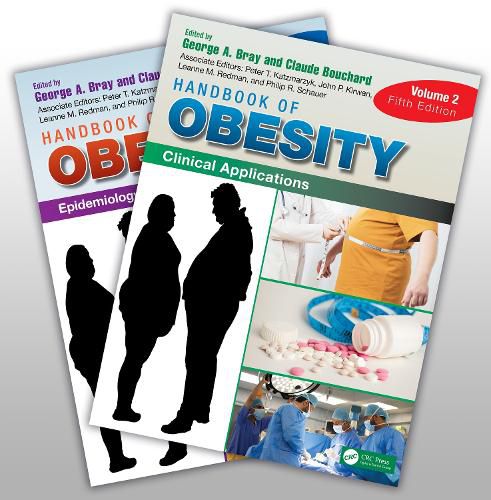Readings Newsletter
Become a Readings Member to make your shopping experience even easier.
Sign in or sign up for free!
You’re not far away from qualifying for FREE standard shipping within Australia
You’ve qualified for FREE standard shipping within Australia
The cart is loading…






This 2 volume set comprises of the 4th edition of Volume 1 and the 5th edition of Volume 2. The fifth edition of Volume 1 of Handbook of Obesity written by global experts covers the basic science aspects under the broad topic areas of epidemiology, etiology, and pathophysiology of obesity. Divided into 5 sections and detailed in 66 chapters, this edition covers the important advances occurring over the past decades. With a focus on science of obesity and factors participating in the etiology of obesity, this topic is studied from biological, behavioural and environmental perspectives.
Volume 1 is structured into 5 parts: Part 1 focuses on the history, definitions, and prevalence of the obesity. Part 2 explains the biological determinants of obesity. Part 3 describes the behavioral determinants of obesity. Part 4 comprises of chapters explaining the environmental, social, and cultural determinants of obesity. Part 5 of this volume discusses the health consequences of obesity.
Volume 2 of the 5th Edition of the Handbook of Obesity spotlights on clinical applications for evaluation, diagnosis, prevention, and treatment of obesity. It covers on the several major developments occurred between the previous and the new edition, including the effect of SARS-CoV-2 on people with obesity, the concept of "Precision Medicine", and new medications approved by USFDA aiding patients with obesity weight loss of 15 to 20%.
This volume is structured into 5 parts: Part 1 provides insights from evolution on changes in diet and physical activity, and the implications and results for preventing obesity, health care costs associated with obesity and the cost-effectiveness of obesity prevention and treatment. Part 2 deals with evaluation of overweight patients, approaches for classifying obesity and using this knowledge to evaluate patients, and addressing ethnic and racial considerations in evaluating patients with obesity. Part 3 explains the impact of lifestyle in managing obesity, which include behavioural management, diet, dietary composition, and meal timing, and the effects of physical activity and exercise in weight loss and weight loss maintenance. Part 4 is focused on medications in the management of obesity. This includes drug selection, various classes of drugs, combination of drugs affecting weight loss, effect of herbal agents on weight loss and treatment of obesity in pediatric populations, genetic diseases causing obesity and the role of drugs in treating the dyslipidemias. Part 5 discusses bariatric surgery, its history, procedure and effects in details, and other surgical techniques including electric stimulation of the vagus nerve, gastric balloons, intestinal liners and liposuction.
$9.00 standard shipping within Australia
FREE standard shipping within Australia for orders over $100.00
Express & International shipping calculated at checkout
This 2 volume set comprises of the 4th edition of Volume 1 and the 5th edition of Volume 2. The fifth edition of Volume 1 of Handbook of Obesity written by global experts covers the basic science aspects under the broad topic areas of epidemiology, etiology, and pathophysiology of obesity. Divided into 5 sections and detailed in 66 chapters, this edition covers the important advances occurring over the past decades. With a focus on science of obesity and factors participating in the etiology of obesity, this topic is studied from biological, behavioural and environmental perspectives.
Volume 1 is structured into 5 parts: Part 1 focuses on the history, definitions, and prevalence of the obesity. Part 2 explains the biological determinants of obesity. Part 3 describes the behavioral determinants of obesity. Part 4 comprises of chapters explaining the environmental, social, and cultural determinants of obesity. Part 5 of this volume discusses the health consequences of obesity.
Volume 2 of the 5th Edition of the Handbook of Obesity spotlights on clinical applications for evaluation, diagnosis, prevention, and treatment of obesity. It covers on the several major developments occurred between the previous and the new edition, including the effect of SARS-CoV-2 on people with obesity, the concept of "Precision Medicine", and new medications approved by USFDA aiding patients with obesity weight loss of 15 to 20%.
This volume is structured into 5 parts: Part 1 provides insights from evolution on changes in diet and physical activity, and the implications and results for preventing obesity, health care costs associated with obesity and the cost-effectiveness of obesity prevention and treatment. Part 2 deals with evaluation of overweight patients, approaches for classifying obesity and using this knowledge to evaluate patients, and addressing ethnic and racial considerations in evaluating patients with obesity. Part 3 explains the impact of lifestyle in managing obesity, which include behavioural management, diet, dietary composition, and meal timing, and the effects of physical activity and exercise in weight loss and weight loss maintenance. Part 4 is focused on medications in the management of obesity. This includes drug selection, various classes of drugs, combination of drugs affecting weight loss, effect of herbal agents on weight loss and treatment of obesity in pediatric populations, genetic diseases causing obesity and the role of drugs in treating the dyslipidemias. Part 5 discusses bariatric surgery, its history, procedure and effects in details, and other surgical techniques including electric stimulation of the vagus nerve, gastric balloons, intestinal liners and liposuction.